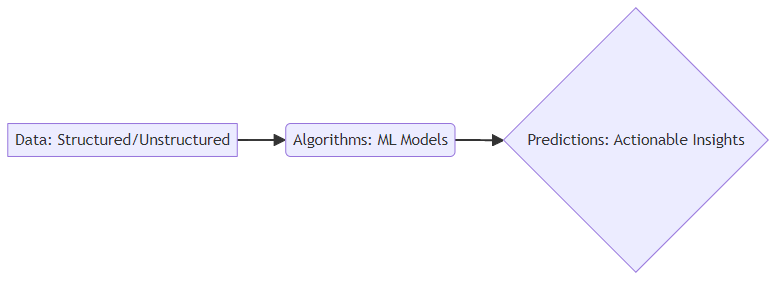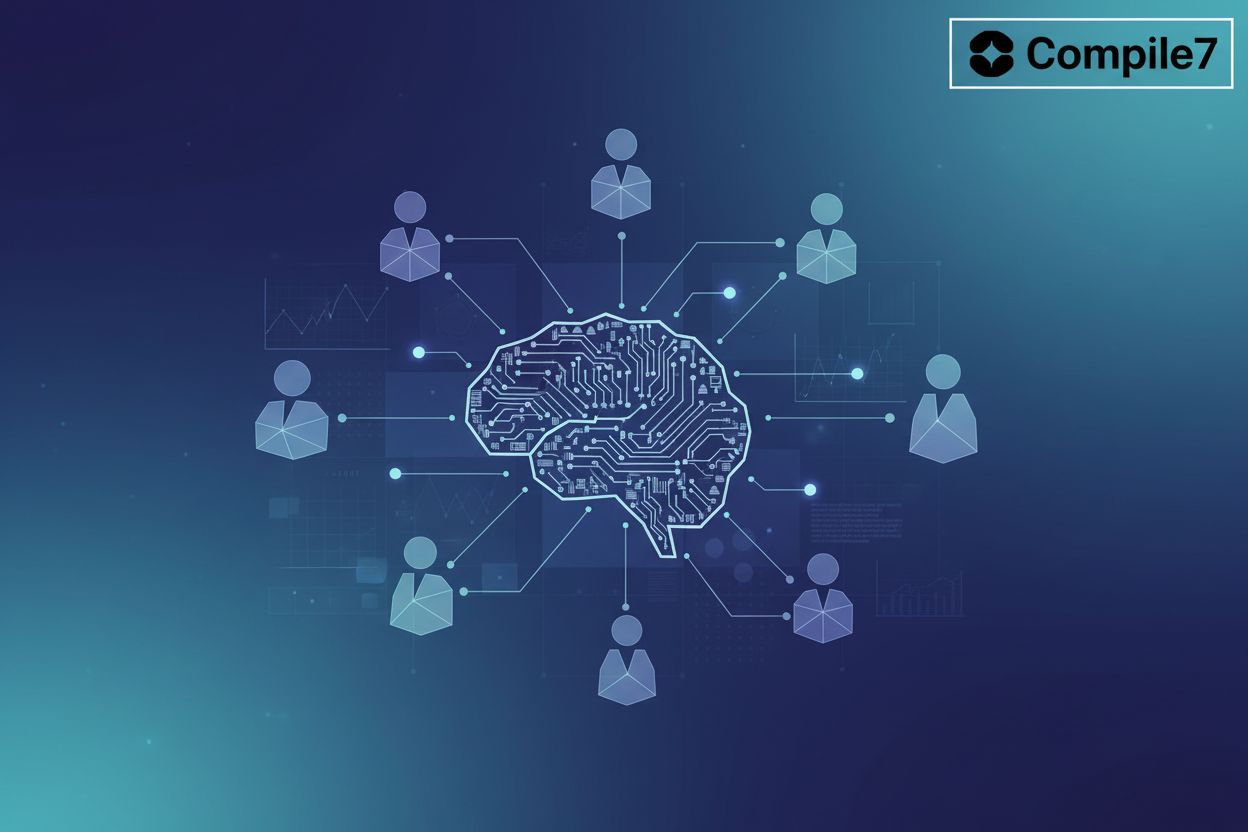AI-Powered Predictive Analytics: Transforming Business Automation and Decision-Making
Understanding AI-Powered Predictive Analytics
Did you know that ai can predict future trends with remarkable accuracy? It's not magic, but the power of ai-powered predictive analytics that transforms how businesses automate and make decisions. Let's dive into how this works.
ai-powered predictive analytics uses artificial intelligence, machine learning, and statistical techniques to forecast future trends and outcomes. (What is predictive analytics and how does it work? | Google Cloud) It evolves traditional predictive analytics through ai-driven automation and enhanced accuracy. The key benefits include improved decision-making, increased efficiency, and proactive risk management.
For example, ai can forecast equipment failure in manufacturing, predict patient outcomes in healthcare, and optimize inventory in retail. This helps organizations prepare for future trends.
The foundation of predictive analytics is data. It includes both structured data (like numbers and categories) and unstructured data (like text and images). Algorithms are the brains behind it all. Machine learning models, such as regression, decision trees, and neural networks, learn from data to make predictions.
Finally, predictions are actionable insights derived from analyzing data. These are used for forecasting trends, identifying anomalies, and making strategic decisions.

ai automates data analysis and identifies patterns faster and more accurately than traditional methods. (What Is AI Analytics?) ai models continuously learn from new data, adjusting parameters to improve predictions in real-time. This automation reduces manual tasks, allowing for more efficient data processing and insight generation. ai achieves this speed and accuracy through capabilities like parallel processing of vast datasets and the application of sophisticated algorithms that can detect subtle correlations traditional methods might miss.
As Mailchimp notes, ai predictive analytics can help you make predictions about the future, ensuring better business decisions.
By understanding the core concepts, you're now ready to explore the practical applications of ai-powered predictive analytics. The next section will cover data collection and preparation, a critical step in the process.
Data Collection and Preparation
Before any ai model can work its magic, you need good data. This step is super important, and honestly, often the most time-consuming part. It's all about getting your data ready so the algorithms can actually learn from it.
Here's what goes into it:
- Data Sourcing: First off, you gotta figure out where your data is coming from. This could be internal databases, customer surveys, external market research, social media feeds, or even IoT devices. You need to identify all the relevant sources.
- Data Cleaning: Raw data is almost never perfect. You'll find missing values, duplicate entries, incorrect formats, and outliers. Cleaning involves identifying and correcting these issues. Think of it like tidying up your room before you can find anything.
- Data Transformation: Sometimes, data needs to be reshaped or converted into a format that the ai model can understand. This might involve aggregating data, creating new features from existing ones (feature engineering), or normalizing values.
- Feature Engineering: This is where you get creative. You're essentially creating new input variables (features) from your existing data that might help the model make better predictions. For example, instead of just using a date, you might create features like "day of the week" or "month of the year."
Getting this right is key. Garbage in, garbage out, as they say.
The AI-Powered Predictive Analytics Process
ai-powered predictive analytics is more than just a buzzword; it's a game-changer. It allows businesses to anticipate future trends, optimize operations, and make more informed decisions.
The predictive analytics process involves several key steps, each crucial for generating reliable insights. These steps transform raw data into actionable predictions.
Algorithm Selection: Choosing the right machine learning algorithm is paramount. The algorithm could be anything from linear regression to decision trees or neural networks. The choice depends on the data's nature and the type of prediction needed.
Model Training: Historical data is fed into the model, enabling it to identify patterns and trends. This training phase is critical, as the model learns from past outcomes to predict future ones.
Validation and Testing: Once trained, the model's accuracy must be evaluated. A separate dataset is used to test the model, ensuring it can generalize its learning to new, unseen data.
The process begins with selecting an appropriate algorithm. For instance, a retailer predicting sales might use time series analysis because it's specifically designed to analyze data points collected over time, making it ideal for spotting trends and seasonality in sales figures. A financial institution assessing credit risk could opt for logistic regression, which is well-suited for binary classification problems like predicting whether a customer will default on a loan.
The model is then trained using historical data. This data must be comprehensive and relevant to ensure the model learns effectively.
Finally, the model is validated using a separate dataset to confirm its accuracy. This ensures the model's predictions are reliable across different scenarios.

According to IBM, predictive ai can query databases quickly and efficiently by using embeddings.
It's important to address ethical considerations. Biases in data or algorithms can lead to unfair outcomes. Ethical ai practices help guard against harmful impacts.
As IBM notes, explainability and transparency in ai models are critical for building trust and protecting regulatory compliance.
Understanding the predictive analytics process empowers businesses to make data-driven decisions. The next step involves deploying the model for real-time predictions and continuous learning.
Real-World Applications Across Industries
Many companies are now using ai to understand their business operations better. But how does this work in practice across different industries? Let's explore some real-world applications.
ai-powered predictive analytics transforms how e-commerce and retail businesses operate. Here's how:
- Inventory Optimization: ai forecasts demand to optimize inventory levels and reduce costs. This ensures businesses have the right products in stock at the right time, minimizing waste and maximizing sales.
- Personalized Marketing: ai analyzes customer behavior to personalize product recommendations and marketing strategies. By understanding individual preferences, retailers can create targeted campaigns that resonate with customers.
- Dynamic Pricing: ai adjusts prices in real-time based on demand and competition. This helps retailers stay competitive and maximize revenue.
Predictive analytics plays a crucial role in the finance sector. Consider these applications:
- Fraud Detection: ai identifies unusual transaction patterns to prevent financial fraud. This protects both the institution and its customers from potential losses.
- Credit Scoring: ai assesses customer creditworthiness and predicts loan defaults. This enables lenders to make informed decisions about lending risk.
- Risk Management: ai anticipates market trends and economic changes to mitigate financial risks. Financial institutions can proactively manage their portfolios and protect against potential downturns.
ai can improve patient care and operational efficiency in healthcare. Here's how:
- Patient Risk Assessment: ai identifies patients at risk of developing certain conditions. Early detection enables proactive interventions and improved patient outcomes.
- Treatment Personalization: ai predicts effective treatments for specific individuals. This ensures patients receive the most appropriate care based on their unique circumstances.
- Predictive Diagnostics: ai can identify potential diseases before they become critical. Early diagnosis can lead to more effective treatment and better health outcomes.
For example, government contract professionals can use ai-powered predictive analytics to forecast potential project delays, identify cost-saving opportunities by analyzing past contract performance, and even predict the likelihood of winning future bids based on historical data and market trends. This helps improve efficiency, reduce costs, and enhance overall contract performance.
ai-powered predictive analytics offers diverse applications across industries. By understanding these real-world applications, businesses can better appreciate the transformative potential of ai. Next, we'll discuss the tools and platforms that make all this possible.
Tools and Platforms for AI-Powered Predictive Analytics
So, you've got your data, you've got your process, now you need the right gear to make it all happen. Luckily, there's a whole bunch of tools and platforms out there to help you build and deploy ai-powered predictive analytics.
Here are some of the main categories you'll run into:
- Programming Languages and Libraries: These are the building blocks.
- Python: This is probably the most popular language for ai and machine learning. It's got a massive ecosystem of libraries.
- R: Another strong contender, especially popular in academia and statistics.
- Key Libraries: Think
scikit-learnfor general machine learning,TensorFlowandPyTorchfor deep learning,Pandasfor data manipulation, andNumPyfor numerical operations.
- Cloud-Based AI Platforms: These offer managed services that simplify a lot of the heavy lifting.
- Amazon Web Services (AWS): Services like Amazon SageMaker provide end-to-end capabilities for building, training, and deploying machine learning models.
- Google Cloud Platform (GCP): Offers Vertex AI, a unified platform for machine learning development, and various specialized ai services.
- Microsoft Azure: Provides Azure Machine Learning, a cloud-based environment for building and deploying ML models.
- Business Intelligence (BI) and Analytics Tools: While not strictly ai development platforms, many BI tools are integrating ai capabilities or can be used to visualize and interpret the results from your ai models. Examples include Tableau, Power BI, and Qlik.
- Specialized AI/ML Platforms: Some platforms focus specifically on making ai development more accessible, often with low-code or no-code interfaces.
Choosing the right tools depends on your team's skills, the complexity of your project, your budget, and whether you prefer to build from scratch or use managed services.
Benefits and Challenges of AI-Powered Predictive Analytics
ai-powered predictive analytics is revolutionizing business, but it's not without its challenges. Understanding both the benefits and potential pitfalls is key to successful implementation.
ai-powered predictive analytics offers several significant advantages:
- Enhanced Decision-Making: Businesses make better decisions using data-driven insights. Instead of relying on gut feelings, organizations can use ai to analyze data and predict future outcomes.
- Increased Efficiency: ai algorithms analyze large datasets faster than humans. This speed leads to more efficient operations, freeing up time for employees to focus on other tasks.
- Proactive Risk Management: ai identifies potential risks early. This allows businesses to take proactive measures to mitigate these risks, which is especially valuable in industries like finance and healthcare.
- Personalization Opportunities: ai helps tailor products and services to individual customer preferences. This results in more effective marketing and increased customer satisfaction.
While the benefits are clear, there are also challenges to consider:
- Data Quality: The accuracy of ai predictions depends on the quality of the data. Poor-quality data leads to inaccurate predictions.
- Model Complexity: Some ai models are complex and lack transparency. This makes it difficult to understand how they arrive at certain predictions.
- Ethical Concerns: Addressing privacy and bias issues is crucial. Businesses must maintain trust and comply with regulations.
- Integration Hurdles: Integrating ai into existing systems can be difficult. This is especially true for organizations with older IT infrastructure.
To effectively use ai-powered predictive analytics, organizations must address these challenges.
To make the most of ai-powered predictive analytics, consider these points:
- Start with a clear goal: Define what you want to achieve with predictive analytics.
- Focus on data quality: Ensure your data is clean, relevant, and up-to-date.
- Choose the right tools: Select ai platforms that fit your needs and expertise.
- Embed ai into your culture: Encourage all departments to think proactively about future trends. This means fostering a mindset where data-driven forecasting is part of everyday operations, not just an IT project. It involves training employees on how to interpret and use predictive insights, and creating processes that integrate these insights into strategic planning and daily tasks.
By addressing these factors, organizations can harness the power of ai for better decision-making.
Successfully navigating these benefits and challenges paves the way for leveraging ai tools effectively. Next, we'll explore the tools and platforms that enable ai-powered predictive analytics.
Implementing AI-Powered Predictive Analytics: A Step-by-Step Guide
Implementing ai-powered predictive analytics can feel like navigating a maze, but with the right steps, you can unlock its transformative potential. Are you ready to learn how to make ai work for your business?
Here's a step-by-step guide to help you get started.
- Define Goals and Objectives: Determine the specific business challenges you want to address. For example, a hospital might aim to predict patient readmission rates to improve care and reduce costs. Set SMART goals to ensure your initiatives are focused and measurable.
- Assemble the Right Team: A cross-functional team is essential. Include data scientists who can build and train models, data engineers to manage data pipelines, and business analysts to translate insights into actionable strategies. Make sure to include IT specialists to ensure seamless integration with existing systems.
Consider a retail chain aiming to optimize inventory. They could use ai to analyze past sales data, seasonal trends, and even local events to predict demand. This allows them to stock the right products at the right time, minimizing waste and maximizing profits.
- Select the Right Tools: Choose platforms and technologies based on your team's expertise, specific needs, and budget. Options range from open-source tools like Python and R to cloud-based services.
When implementing ai, data security is paramount. Implement robust data governance and security measures to protect sensitive information. This includes encryption, access controls, and compliance with data privacy regulations.

By following these steps, you'll be well on your way to harnessing the power of ai-powered predictive analytics.
Now that you have a plan, the next step involves collecting and preparing your data for analysis.
Ethical Considerations and Best Practices
ai's ability to analyze vast datasets brings immense power, but it also introduces complex ethical considerations. Are you prepared to navigate the ethical landscape of ai-powered predictive analytics?
One of the primary ethical challenges is bias. Training ai models on data that isn't diverse can lead to skewed outcomes.
- Data Diversity: Use diverse and representative datasets to train models. This helps prevent biased outcomes that unfairly impact specific groups.
- Algorithm Transparency: Understand how ai models reach their predictions. This transparency is critical for spotting and fixing potential biases in the algorithm.
- Ethical Guidelines: Stick to ethical ai principles and regulations. Doing so ensures accountability and fairness in all applications.
Protecting data is another vital ethical consideration. Organizations must safeguard sensitive information used in predictive analytics.
- Data Anonymization: Use anonymization techniques to protect sensitive data. This reduces the risk of exposing personal information.
- Compliance: Follow data protection regulations like GDPR and CCPA. Compliance ensures you handle data legally and ethically.
- Security Measures: Implement robust security protocols to prevent data breaches. Protecting data from unauthorized access is paramount.
Explainable ai (XAI) and transparency are crucial for building trust in ai systems. If stakeholders don't understand how an ai model makes decisions, they're less likely to trust it.
- Explainable ai (XAI): Use techniques to make ai model decisions understandable. XAI helps stakeholders grasp how the model works.
- Transparency: Provide clear documentation of ai model processes. This transparency builds confidence in the model's reliability.
- Building Trust: Enhance trust by ensuring ai decisions are justifiable. Transparent and explainable decisions increase user confidence.
By addressing bias, protecting data, and promoting transparency, organizations can harness ai responsibly. The next section will explore the tools and platforms that enable ai-powered predictive analytics.
The Future of AI-Powered Predictive Analytics
ai-powered predictive analytics is rapidly evolving, promising even more powerful tools for business automation and decision-making. What does the future hold for this transformative technology?
Advancements in ai will continue to improve predictive accuracy. New techniques and algorithms are constantly being developed to enhance the ability of ai to analyze data and forecast outcomes.
Integration with the Internet of Things (IoT) will provide real-time insights. Combining predictive analytics with IoT data enables businesses to monitor operations continuously and make immediate adjustments based on current conditions.
Edge computing will allow for faster, more localized predictions. Deploying ai models on edge devices reduces latency and enables quicker responses to changing conditions.
Driving innovation through predictive analytics helps businesses identify new opportunities. By forecasting future trends and consumer behaviors, companies can develop innovative products and services that meet emerging needs.
Strategic alignment is achieved by integrating predictive analytics into core business strategies. This ensures that decisions are data-driven, leading to more effective outcomes.
Competitive advantage is gained by leveraging ai-powered insights. Companies that use predictive analytics effectively can anticipate market changes and outperform their competitors.
According to a March 2024 article in European Business Magazine, "ai will augment the capabilities of procurement teams and is expected to create 133 million new jobs by 2030."
- Monitoring performance is critical for maintaining the accuracy of predictive models. Regularly tracking the performance of ai models ensures they continue to deliver reliable insights.
- Feedback loops are essential for refining models. Establishing mechanisms to capture real-world performance data allows models to learn from their successes and failures, improving future predictions.
- Adaptability ensures models remain effective over time. Models must be able to adjust to changing business conditions and incorporate new data to stay relevant.
The future of ai-powered predictive analytics is bright, offering businesses unprecedented opportunities. By embracing these emerging trends and best practices, organizations can transform their operations and gain a competitive edge.





